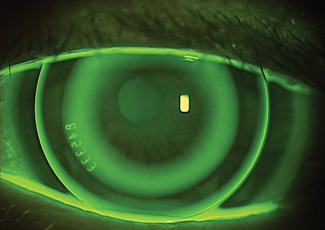 |
| The 5mm BOZD ortho-K could better control myopia than the 6mm BOZD ortho-K. Comparing the changes between the two different BOZD groups, our study found that the 5mm group had a smaller treatment zone diameter, less decentration, more defocus and higher HOAs. Photo: Robert Ensley, OD, and Heidi Miller, OD. Click image to enlarge. |
A recent short-term study reported that ortho-K designed with a smaller back optic zone diameter (BOZD) could produce greater peripheral defocus, higher higher-order aberrations (HOAs) and a smaller treatment size, while effective slowing of axial elongation was reported by other long-term follow-up studies. Researchers in China attempted to identify the indicator that best predicts myopia progression and to find the optimal cut-off value of that variable to further improve myopia control for clinical ortho-K wearers. They found that treatment zone was the best predictor of axial elongation, and that a diameter less than 3.82mm may lead to axial length (AL) elongation less than 0.2mm in one year.
This prospective cohort study included 301 seven- to 14-year-old children fitted with ortho-K lenses of 5mm or 6mm BOZD. The children were required to wear the lenses for at least eight consecutive hours per night and at least six days per week. AL, corneal topography, HOAs and Zernike defocus coefficient were obtained at baseline, and one, three, six, nine and 12 months follow-up visits.
The treatment size and decentration were smaller, while the Zernike defocus coefficient and HOAs were higher, in the 5mm group. Decreasing the BOZD by increasing HOAs, raising the Zernike defocus coefficient (meaning steeper peripheral defocus) and reducing the treatment zone size increased the effectiveness of myopia control.
Older age and smaller treatment zone size were protective factors against AL elongation in multiple regression. In predicting AL elongation, treatment zone diameter yielded an area under the receiver operating characteristic curve of 0.684, with a cut-off value of 3.82mm. Treatment zone diameter was the best predictor of one-year axial elongation when divided into rapid (AL changes > 0.2mm) and slow (AL changes ≤ 0.2mm) groups.
The mean AL change in the 5mm group (0.13mm) was less than that in the six-mm group (0.27mm) at the 12 months visit. “This means that the control effect of the 5mm group is 51.8% better than that of the 6mm group,” the researchers wrote in their paper. The results showed that 38.3% of patients in the 6mm group and 59.3% of patients in the 5mm group had axial growth of 0.2 mm or less in one year, indicating that a higher proportion of patients with 5mm BOZD ortho-K could achieve superior control effects.
“Our research further validates the reason that smaller BOZDs produce better myopia control effects and proposes a treatment size threshold for an improved effect, which is helpful for efficient myopia control,” the study concluded.
Li X, Zuo L, Zhao H, et al. Efficacy of small back optic zone design on myopia control for corneal refractive therapy (CRT): a one-year prospective cohort study. Eye Vis (Lond). 2023;10(1):47. |

